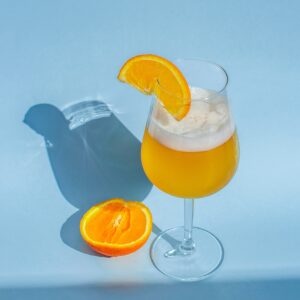The Mimosa is a classic brunch cocktail that combines the vibrant flavors of champagne and orange juice. Whether you’re celebrating a special occasion, hosting a brunch party, or simply enjoying a lazy weekend morning, the Mimosa is the perfect choice to elevate your brunch experience.
In this post, we’ll quickly dive into the history of the Mimosa, provide a step-by-step guide on how to make the perfect Mimosa at home, and share some creative variations to suit different tastes. And so, let’s get a bottle of champagne & toast to us – we’re learning new things, after all.
Here’s our Mimosa recipe:
A Brief History of the Mimosa
The Mimosa cocktail originated in Paris, France, in the early 20th century. It was named after the yellow flowers of the mimosa plant, which bloom during the winter season. The drink gained popularity in the 1920s and soon became a staple in brunch culture around the world.
The original Mimosa recipe consisted of equal parts champagne and freshly squeezed orange juice. Its simplicity and refreshing taste made it a favorite among brunch enthusiasts and cocktail connoisseurs alike.
The Essential Ingredients
To create the perfect Mimosa, you will need the following ingredients:
- 2 parts champagne or sparkling wine
- 1 part freshly squeezed orange juice
- Orange slices, for garnish (optional)
When it comes to champagne or sparkling wine, choose a dry or semi-dry variety that suits your preferences. Opt for a high-quality bottle that balances well with the sweetness of the orange juice. Freshly squeezed orange juice is key to achieving the vibrant and tangy flavors of a classic Mimosa.
Step-by-Step Guide to Crafting the Perfect Mimosa
Now that we have our ingredients ready, let’s dive into the step-by-step process of making a Mimosa:
- Chill the champagne and orange juice in the refrigerator for at least an hour before preparing the cocktail.
- Take a champagne flute and pour champagne or sparkling wine into it, filling it about two-thirds of the way.
- Slowly pour the freshly squeezed orange juice into the flute, filling the remaining one-third.
- Gently stir the mixture with a long spoon to combine the flavors.
- Optional: Garnish the glass with a slice of orange for an elegant presentation.
- Your perfect Mimosa is now ready to be enjoyed!
Creative Variations of the Mimosa Recipe
While the classic Mimosa recipe is delightful on its own, there’s always room for experimentation and personalization. Here are a few creative variations to consider:
- Pineapple Paradise Mimosa: Replace orange juice with pineapple juice for a tropical twist. Garnish with a pineapple wedge for an extra touch of paradise.
- Berry Burst Mimosa: Add a splash of berry liqueur, such as Chambord or Crème de Cassis, to the classic Mimosa for a burst of fruity flavors. Garnish with fresh berries for a colorful presentation.
- Ruby Red Grapefruit Mimosa: Swap out orange juice for freshly squeezed ruby red grapefruit juice for a tangy and refreshing twist. Garnish with a grapefruit twist for a visually appealing cocktail.
- Elderflower Elegance Mimosa: Mix elderflower liqueur with the champagne and orange juice to add a floral and delicate note to the cocktail. Garnish with an edible flower for an elegant touch.
Feel free to experiment with different fruit juices, liqueurs, and garnishes to create your own signature Mimosa that suits your taste preferences.
Frequently Asked Questions (FAQs)
Q: What is the origin of the Mimosa cocktail?
The Mimosa cocktail originated in Paris, France, in the early 20th century. It was named after the yellow flowers of the mimosa plant, which bloom during the winter season.
Q: Can I use a different type of sparkling wine for the Mimosa?
Absolutely! While champagne is the traditional choice, you can use any sparkling wine that suits your taste and budget. Prosecco, Cava, or sparkling rosé are popular alternatives that work well in a Mimosa.
Q: Is it possible to make a non-alcoholic version of the Mimosa?
Certainly! To make a non-alcoholic Mimosa, simply replace the champagne with sparkling non-alcoholic wine or sparkling water. The combination of sparkling liquid and freshly squeezed orange juice will still provide a delightful and refreshing drink.
Q: Can I use store-bought orange juice for the Mimosa?
While it is convenient, using freshly squeezed orange juice is recommended for the best flavor. Store-bought orange juice may contain added preservatives or artificial flavors that can affect the taste of the Mimosa. For the freshest and most vibrant flavors, opt for freshly squeezed orange juice.
Q: What garnishes work well with the Mimosa?
A slice of orange is the classic garnish for a Mimosa, but you can get creative with your garnishes. Fresh berries, mint leaves, or even a sugared rim can add a touch of elegance and visual appeal to your cocktail.
Q: What are some alternative fruit juices I can use in a Mimosa?
While orange juice is the traditional choice, you can experiment with other fruit juices to create unique flavors. Pineapple juice, grapefruit juice, cranberry juice, or even a blend of different fruit juices can be used as alternatives to orange juice.
Conclusion
The Mimosa is a classic brunch cocktail that adds a touch of elegance and celebration to any occasion. With its origins rooted in the vibrant city of Paris, the Mimosa continues to be a favorite among brunch enthusiasts around the world.
By following our step-by-step guide and exploring creative variations, you can create the perfect Mimosa to suit your taste preferences. Whether you’re enjoying a leisurely brunch at home, hosting a special gathering, or toasting to a memorable moment, the Mimosa recipe is a must-have in your repertoire.
So, gather your champagne, squeeze some fresh oranges, and indulge in the delightful flavors of the Mimosa. Cheers to good company, great food, and a fantastic brunch experience!

Mimosa
A simple mimosa recipe to enhance your next brunch.
Ingredients
- 2 parts champagne
- 1 part orange juice freshly squeezed
- 1 slice orange garnish
Instructions
-
Chill the champagne and orange juice in the refrigerator for at least an hour.
-
Take a champagne flute and pour champagne or sparkling wine into it, filling it about two-thirds of the way.
-
Slowly pour the freshly squeezed orange juice into the flute, filling the remaining one-third.
-
Gently stir the mixture with a long spoon to combine the flavors.
-
Optional: Garnish the glass with a slice of orange for an elegant presentation.


